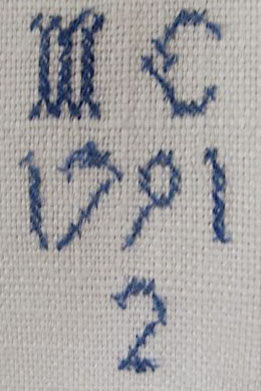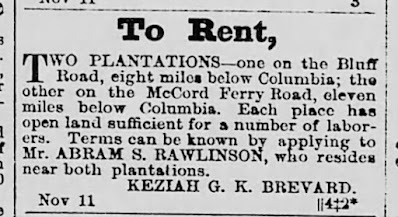The IK Foundation
"Gave Mary an old sheet. Made in 1842 no 1 for a quilt lining."
Just before the Civil War Keziah Brevard mentioned using an old linen sheet for a quilt backing,
something perhaps marked with cross stitch like this one. Sheets were often marked with the owner's initials, the date and a number. We don't know who quiltmaker Mary was but she was probably an enslaved seamstress on one of Keziah's South Carolina plantations.
Another quilting reference by the plantation owner"
"Dorcas has commenced a quilt. I've gave her the scraps."
Documents of enslaved people stitching patchwork are rather rare. In 1861, a few months before the Civil War, Keziah Brevard mentioned that she gave her young companion Dorcas scraps to sew. Who Dorcas was remains a mystery but she seems to have been one of Keziah's many enslaved people. They were fond of each other.
An imaginary Dorcas, a girl in a checked apron
"My little servant Dorcas sits beside me while I write---I cannot persuade her to go to bed---she says it is so cold, she has her bed----three blankets & a No. Ca. Coverlet to cover with. I cannot help laughing at her---she dreads the cold so much." March, 1861
North Carolina coverlet in the collection of the Smithsonian
Keziah Goodwyn Hopkins Brevard (1803-1886)
Painting in family collection probably dating from her wedding in the late 1820s.
Reading about Dorcas and her coverlet is one warm entry in Keziah's journal of the year before the war. When shooting began at Fort Sumter in April, 1861, the journal ends. Dorcas was one of about 200 people that Keziah "owned." The 1850 census slave schedule shows quite a roster of unnamed people, just a portion of her empire that was estimated to consist of 200 persons.
Her luck was poor regarding that husband Alexander Joseph Maclean Brevard (1801-1842.) He had land and promise but alcohol and mental illness quickly destroyed their marriage. She went home to her father. Her husband spent time in mental institutions. Her father died two years after her husband, leaving her this house she called Brevard House. She owned four plantations during the war.
Although the unhappy journal tells us nothing about Keziah's life during the war we can imagine the pattern of isolation and bad temper endured as she continued to live among people she oppressed who seem to have despised her as much as she did them.
Her house in Eastover, probably still standing, was called Alwehav by
a later owner. Keziah added to the family house in the 1850s.
After the war: 1865 Columbia Daily Phoenix
Half-sister Sarah Cooke Goodwyn Hall (1791-1867), appears to have had more problems than she, lived with Keziah during the war as did other family refugees.
The 1850 census listed sister Sarah as "insane."
I read these diaries for insight into quilts, textiles and culture---and for entertainment, romanticizing about far away times and places but Keziah is one woman you do not want to spend much time with.
We can only hope she continued to be somewhat kind to Dorcas and that the girl got that quilt done.
John Middleton maintains a Facebook group connecting descendants of people who worked on the Brevard plantations:










No comments:
Post a Comment